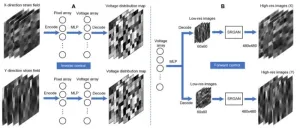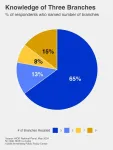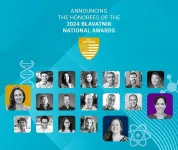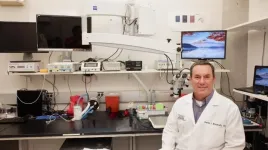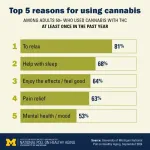(Press-News.org) (WASHINGTON – September 12, 2024) The risk of venous thromboembolism (VTE), or blood clots, in individuals with sickle cell trait (SCT) is higher than in individuals without the trait. However, the risk is lower than for those with heterozygous factor V Leiden (FVL), according to a study published today in Blood Advances that analyzed genetic data from 23andMe research participants.
More than 100 million people worldwide and approximately 7% of Black individuals in the United States have SCT. Unlike sickle cell disease, which occurs in patients with two genes that cause abnormalities in the production of hemoglobin – the oxygen-carrying substance in red blood cells – individuals with SCT carry only one sickle hemoglobin gene and typically lead normal lives.
Although SCT is generally asymptomatic, it is a risk factor for some complications, including VTE, which manifests either as deep vein thrombosis (DVT), when a blood clot forms in the deep veins, or pulmonary embolism (PE), when a blood clot blocks an artery in the lung. In both cases, VTE can be life-threatening. However, VTE is not a risk unique to SCT; it can be triggered by surgery or major injury, and it is also associated with heterozygous FVL, the most common inherited blood-clotting disorder, which is caused by one defective factor V gene.
“SCT is erroneously associated only with Black individuals, even though it is found in very diverse populations,” said study author Rakhi Naik, MD, MHS, associate professor of medicine at Johns Hopkins University. Dr. Naik added that this association is in part attributable to SCT research having been conducted solely in Black individuals. “When we do research within a specific population, we often make the incorrect assumption that the genetic trait is found only in that population, even though it is found quite broadly,” she said.
This means that providers may omit FVL testing in Black patients with VTE, while testing for SCT is often limited to Black patients only. In combination with systemic racism, the association of SCT solely with Black individuals has led to general misinformation as well as over-attribution to systemic disease. As a result, Black individuals with SCT have historically faced employment and insurance discrimination; however, new genetic testing technology and a greater recognition of the inequities that accompany race-based research have given rise to easier, more affordable analysis of large, diverse SCT sample sizes.
In partnership with a research team led by Keng-Han Lin, PhD, senior statistical geneticist at 23andMe, Dr. Naik and her colleagues sought to contextualize the risk of VTE in SCT, irrespective of race or ethnicity, by comparing it to the risk associated with FVL, a condition with a known risk factor for VTE. In the largest study to date on SCT and blood clots, the researchers leveraged DNA samples from 4,184,082 participants from the 23andMe research cohort ages 18-100 with self-reported data on VTE, DVT, and PE.
Overall, the prevalence of SCT in the study cohort was 0.46% (19,055), with the highest prevalence observed in individuals with African ancestry (7.02%), Latine ancestry (0.67%), and South Asian ancestry (0.16%). In comparison, the overall prevalence of FVL was 4.45% (186,277), with the highest prevalence observed in individuals with European ancestry (5.19%), Latine ancestry (2.83%), and South Asian ancestry (2.55%).
A history of VTE was reported by 2.57% of individuals with SCT compared to 2.25% of individuals without SCT, while a history of VTE was reported by 6.93% of those with FVL compared to 2.04% of those without FVL.
After meta-analysis, the researchers found that independent of race or ancestry, the risk of VTE in individuals with SCT was 1.45 times that of those without SCT. However, this is lower than the risk associated with individuals with FVL, who have 3.35 times the risk of those without the disorder. Furthermore, they found that PE (1.58% of those with SCT vs. 0.90% of those without) was the most common manifestation of VTE in those with SCT, whereas DVT (4.59% vs. 1.21%, respectively) was the most common manifestation in those with FVL.
“We were able to show a PE-predominant pattern of blood clots for those with SCT, and our study was able to demonstrate this pattern with statistical significance, which has never been done before,” Dr. Naik said. “This points to a unique mechanism of clotting in SCT, which warrants further research.” The researchers want to see better contextualization of the risk of VTE in people with SCT so that it can inform clinical practice guidelines and minimize unintended bias.
“Very few clinicians know how to counsel someone with SCT,” said Dr. Naik. “This study shows that SCT in itself is not a disease. It’s a risk factor like FVL, and the risk is still very small.”
“I hope this study informs health professionals, particularly hematologists, that when thinking about risks related to SCT, they need to be looking at all populations, not just one group,” said study author Vence L. Bonham Jr., JD, acting deputy director of the National Human Genome Research Institute. “SCT is understudied, and this is an area of opportunity for more research, particularly for other studies with large sample sizes.”
This study had several limitations, primarily the inclusion of self-reported data on DVT and PE phenotypes, as well as provoking factors. Additionally, the researchers did not have genotypic data on alpha-thalassemia, which can modify phenotype in SCT.
###
Blood Advances (bloodadvances.org) is an online, open-access journal publishing more peer-reviewed hematology research than any other academic journal worldwide. Blood Advances is part of the Blood journals portfolio (bloodjournals.org) from the American Society of Hematology (ASH) (hematology.org).
Claire Whetzel, 202-629-5085
cwhetzel@hematology.org
END
A research paper by scientists at Purdue University presented a deep learning method that enables the customization of complex strain fields according to specific requirements.
The new research paper, published on Aug. 14 in the journal Cyborg and Bionic Systems, used a deep learning method based on image regression and achieved to predict and customize complex strain fields.
Traditional bioreactors, powered by pneumatic actuators or motors, struggle to generate complex strain fields due to limited control over individual actuators. However, fields like cardiovascular biomechanics and tissue engineering require more advanced customization. “In the field of biomechanics, customizing ...
Highlights:
Diastatic yeasts can spoil craft beer through hyperattenuation, which boosts the alcohol content and causes bottles to explode.
Killer toxins, which are produced by other yeast strains, hint at a remedy.
In a proof-of-concept study, researchers found that killer toxins inhibited up to 95% of diastatic yeasts.
More work is needed to fine tune the recipe, but killer yeasts may help brewers remedy potentially contaminated beers.
Washington, D.C. — Sept. 12, 2024 — When diastatic strains of Saccharomyces cerevisiae, ...
DALLAS, September 12, 2024 — The American Heart Association, celebrating 100 years of lifesaving service in 2024, is recognizing 21 students, educators and elementary, middle and high schools from across the country who are making a bold impact in the battle against cardiovascular disease – the nation’s leading cause of death. These exceptional individuals and institutions were honored for their unwavering commitment to the Association’s in-school programs, Kids Heart Challenge™ ...
A new study has revealed for the first time how different synthesis methods can profoundly impact the structural and functional properties of high entropy oxides, a class of materials with applications in everyday electronic devices. The study was published this week in the Journal of the American Chemical Society.
“The specific material that we’ve studied here is a high entropy oxide with a spinel crystal structure, which is a mixture of five different transition metal oxides. A lot of the excitement that we ...
Less than half of Americans can name most of the rights protected under the First Amendment and under two-thirds can name the three branches of government, according to the Annenberg Constitution Day Civics Survey, released annually since 2014.
The Annenberg Public Policy Center’s nationally representative survey, conducted in May 2024 with about 1,600 U.S. adults, finds levels of public knowledge largely unchanged from 2023. As was true last year, most Americans could name only a single right guaranteed by the First Amendment: freedom of speech, provided by nearly 3 in 4 respondents.
The survey also found strong public support for ...
NEW YORK, September 12, 2024 – For the second time, the Blavatnik Family Foundation and The New York Academy of Sciences named three women scientists as Laureates of the Blavatnik National Awards for Young Scientists. Each will receive $250,000, the largest unrestricted scientific prize offered to America’s most promising, faculty-level scientific researchers under 42. Three independent juries – one each for life sciences, chemical sciences, and physical sciences & engineering – composed of some of America’s most distinguished scientists selected the three winning Laureates. An additional 15 Finalists will each receive ...
After more than a decade of research growth and recruiting efforts to build strong, collaborative research programs, the Jerry H. Hodge School of Pharmacy in Amarillo has developed the Brain Drug Discovery Center, the newest Texas Tech University Health Sciences Center (TTUHSC) research center.
Created from two existing pharmacy school centers — the Center for Blood-Brain Barrier Research and the Cancer Biology Research Center — the Brain Drug Discovery Center will focus on ...
A QB3-led team uniting researchers from the University of California campuses at Berkeley, San Francisco, and Santa Cruz was awarded a $12 million grant from the California Institute for Regenerative Medicine (CIRM) to investigate the origins of autism using sophisticated cellular models called “neural organoids.”
This grant is the first funding brought in by QB3’s Collaborative Research initiative, which was recently created to address major challenges in human health by leveraging research talent and resources across the UC campuses served by QB3.
"We are grateful for the support provided by the CIRM team to craft a highly successful application ...
Whether they’re using it for recreational or medical reasons, a sizable percentage of people in their 50s and older have smoked, eaten, drunk or applied to their skin at least one form of cannabis in the past year, a new poll shows.
In all, 21% of people age 50 and older said they used a form of cannabis that contains the psychoactive compound THC at least once in the past year, according to new findings from the University of Michigan National Poll on Healthy Aging. The poll report focuses on use of cannabis ...
Mill Valley, CA – September 12, 2024 – The SynGAP Research Fund 501(c)(3) announces a $128,888 grant to Dr. Baptiste Lacoste at the uOttawa Brain and Mind Research Institute (uOBMRI) and Ottawa Hospital Research Institute (OHRI). This grant supports Dr. Lacoste's pioneering research project aimed at exploring the role of vascular and metabolic dysfunction in SYNGAP1-Related Non-Syndromic Intellectual Disability (SYNGAP1-NSID), also known as SYNGAP1-Related Disorders (SRD).
With elevated energy demands and a limited capacity to store ...
